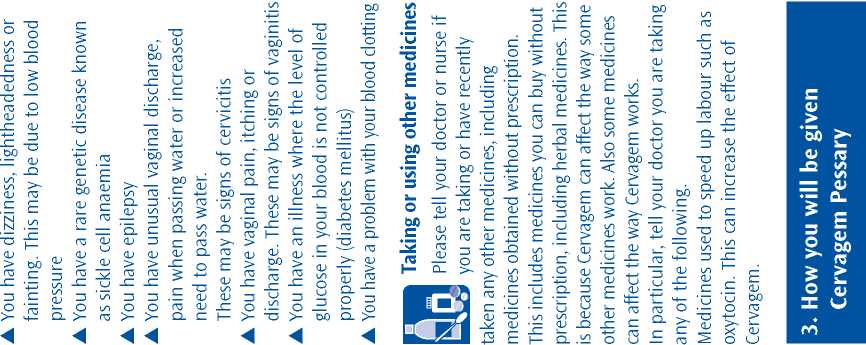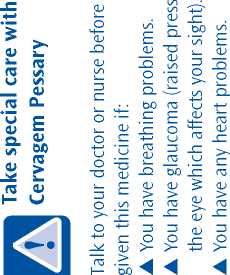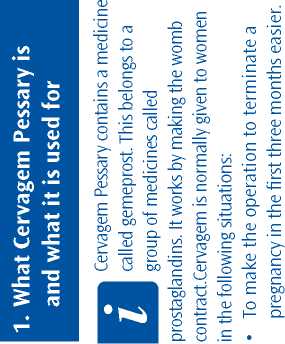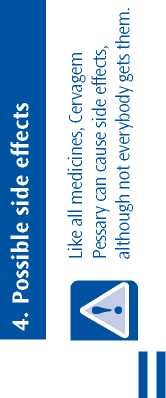Cervagem 1mg Pessary
Out of date information, search anotherStore below minus 10°C (-10°C) in the original pack

o
o
*bO
<D O Cl ^ r- O
LJ -Q I— I—
bo
TO
>
"a
qj t
CD W1
l£) in
<D
QJ
QJ Qj
C _Q
CL C
QJ CL)
O
~a
$ E

r3, ^
QJ O Q.
z: t>o w— TO 03 O
« > 0)
QJ <L> C. +-> Q- LJ O *i7i
PRESENTATION
White to yellowish-white spindle shaped vaginal pessaries each containing 1mg GEMEPROST
INDICATIONS
Softening and dilatation of the cervix uteri prior to trans-cervical intrauterine operative procedures in pregnant patients in the first trimester of gestation.
Therapeutic termination of pregnancy in patients in the second trimester of gestation, in licensed institutions.
_ Induction of abortion of second trimester pregnancies complicated by intrauterine | foetal death.
ADMINISTRATION AND DOSAGE
Before administration, the pessary should be allowed to warm to room temperature for 30 minutes, away from direct heat and sunlight, in the unopened foil sachet.
1. Softening and dilatation of the cervix in the first trimester of gestation.
Adults: One pessary to be inserted into the posterior vaginal fornix 3 hours before surgery.
2. Therapeutic termination of pregnancy in the second trimester of gestation.
Adults: One pessary to be inserted into the posterior vaginal fornix at 3-hourly intervals to a maximum of 5 administrations. If abortion is not established after 5 pessaries, a second course of treatment may be instituted starting 24 hours after the initial commencement of treatment.
If abortion is not well established after 10 pessaries, a further course of CERVAGEM treatment is not recommended and alternative means should be employed to effect uterine emptying
3. Intrauterine foetal death in the second trimester of gestation.
One pessary to be inserted into the posterior vaginal fornix at 3-hourly intervals up to a maximum of 5 administrations.
Elderly: Not applicable.
Children: Not applicable.
CONTRAINDICATIONS
CERVAGEM should not be administered to women with known hypersensitivity to prostaglandins or to women with renal function disturbances. CERVAGEM is also contraindicated in women experiencing uterine fragility related to uterine scarring, and in placenta previa.
CERVAGEM pessaries should not be used for the induction of labour or cervical I softening at term as foetal effects have not been ascertained.
4—■ <D ~o
QJ -C QJ
-? r ^5
bO O
p J=
bO O
p J=
^ -a £ E c qj
(—TOO
>>
to
QJ
</>
QJ
Q.
O
Q
X
qj QJ
to5 -5
-£ .9
° t;
QJ CL)
cd
bO _0 O
_aj ^ bO
C - CL)
i/i Q-TO O
O
£ TO £
qj QJ DO "O JO . =3 O
^ cd o
di | 3 -2
S) ^ a; ' C £ c O
o o o o
° °
TO CD
P *bo
o
CL> *0 q_
£ ^ o
QJ ' '
a. -Q
"O
QJ
O
i/i QJ
"F >
Qj V bn — P
JO
o
=3 CL
QJ QJ
Q- v—
O O
to £3
"a „
Q.
bo
LU
CO
|
LL o |
o |
a> |
QJ | |||||
|
z < C/3 |
"O re |
C4 c o Q. |
o |
"E |
*0 <D E | |||
|
'S |
r^. | |||||||
|
E |
TO |
4—i1 |
-Si |
■o re a> |
1^ rsi |
o "5 |
IE c | |
|
flj |
LO |
CO |
PO |
TO _0J |
> | |||
|
DiO |
Q. |
O Q. |
** CO |
o a> 04 (/) |
IT) re- oo o |
IE |
QJ TO |
"O
TO
QJ
O
o
>-
w O — >• TO QJ
^ OJ3 P
a3£ f,
O _Q
TO Oi D
o r
"O QJ
o zz

QJ TJ C TO
= C 7=' 4-> °
QJ O CD QJ TO v—
bo +2 to TO O
o _Q.
Q- TO
O
>-
i/i "O o QJ
O '
,32 QJ ~Z> ^ O
bO 23 QJ
- y=
CD CD
y=
CD
"O
CD
"O
CD TO -£ CD
o
6
Q.
4—■"
CD
QJ
TO
QJ
O
"O
TO TO i/i vi CD TO Q_ CD
b/D CD TO bO > TO
CD
> CD CD bo > y= _ qj bO c
>
CD
' O "O
qj O o C 3

IIIIIIII
ilium
PRECAUTIONS
CERVAGEM should be used with caution in patients with obstructive airways disease, those with cardiovascular insufficiency, elevated intraocular pressure, cervicitis or vaginitis.
Serious, potentially fatal, cardiovascular accidents (myocardial infarction and/or spasm of the coronary arteries and severe hypotension) have been reported with protaglandins including CERVAGEM,
Cardiac and vascular parameters should be monitored by taking regular measurements of the patients pulse and blood pressure. Coagulopathy may occur following intrauterine foetal death and should be monitored and managed actively according to current standard clinical practice.
Patients with the following diseases have not been studied: ulcerative colitis, diabetes mellitus, sickle-cell anaemia, epilepsy, disorders of blood coagulation, cardiovascular or pulmonary disease.
If it is necessary to postpone surgery for much beyond the recommended 3 hour interval, patients should be kept under observation as there is a possibility that spontaneous abortion may occur.
Adequate follow-up of the procedure is essential to ensure that the termination process has been completed as the embryopathic effects of CERVAGEM have not been determined, CERVAGEM pessaries should not be used for the induction of labour or cervical softening at term as foetal effects have not been ascertained, INTERACTIONS
Oxytocin and other labour inducers or accelerators can potentiate the action of CERVAGEM,
SIDE-EFFECTS
Vaginal bleeding and mild uterine pain, similar to menstrual pain, may occur in the interval between the administration of the pessary and surgery, especially if this interval is prolonged beyond the recommended 3 hours. Nausea, vomiting, loose stools or diarrhoea may occur but are rarely severe enough to require treatment. However, standard anti-emetic or anti-diarrhoeal agents may be administered if required. Other reported side-effects include headache, muscle weakness, dizziness, flushing, chills, backache, dyspnoea, chest pain, palpitations and mild pyrexia.
Uterine rupture has been reported on rare occasions, most commonly in multiparous women with a history of uterine surgery.
Anaphylactic reactions have not occurred with CERVAGEM but such reactions have very rarely been noted with other prostaglandins.
In very rare cases, severe hypotension and coronary spasms with subsequent myocardial infarctions have been reported.
Reporting of side effects
If you get any side effects, talk to your doctor, pharmacist or nurse. This includes any possible side effects not listed in this leaflet. You can also report side effects directly via the Yellow Card Scheme at: www.mhra.gov.uk/yellowcard By reporting side effects you can help provide more information on the safety of this medicine.
OVERDOSAGE
The toxic dose of CERVAGEM in women has not been established. Cumulative dosage of 10mg in 24 hours has been well tolerated. In animals the acute toxic effects are similar to those of prostaglandin E1 and include depression of the CNS and relaxation of the smooth muscle, leading to hypotension. Clinically valuable signs of impending toxicity are likely to be sedation, tremor, convulsion, dyspnoea, abdominal pain and diarrhoea, which may be bloody, palpitations or bradycardia. Treatment should be symptomatic. A vaginal douche may be of value depending on the elapsed time since insertion of the pessary. PHARMACEUTICAL PRECAUTIONS
Store below minus 10°C(-10°C) in the original pack. Temperature cycling should be avoided. Once the foil sachet has been opened, any pessary not used within 12 hours should be destroyed. ©
Aventis Pharma Ltd, One Onslow Street, Guildford, Surrey, GU1 4YS, UK Manufactured by: SANOFI-AVENTISS.P.A., Loc. Valcanello, 03012 Anagni (FR), ITALY | Text issued: March 2012. 89027065
a; £ n
£ !H
Q.H
CD
<D "O t C '
>- X
2 o
TO
CD
CD
o o
<v 'r~
a; 00
CD O bO-Q
> V.
CD
CD
_Q
o a. E
x c-<u
CD
a. =3
- CD "O X 12= O O _Q
Q."0 TO
<D — E
^ U i/)
°
Q.J
£ o
CD = CD 03
2-t o
TO ^ J-— is) CD
to aj He 5 E-G | £=5 tn
TO 03
° h
CD oo -
S.L
oo • —
O
Q.
O
-i—|
_Q-
<D
O
>
TO
CD
O TO o bo
>-£ re ^ ‘ & C
£■§
<L} 00
CD TO >
t tj a. ro
W CD
5
CD
"O _
CD ^3
2 CD o "a CD "O
J2
o
o
3=
o
"9 o
CD CD
Q-
TO 0-
£ % TO -C 00 ** •
5*5
u c
to
Jg
5 8-
*-_Q _P
TO • 3 E -
TO
= sl £ ^ .2 t CM -g
5 ro E
' D9 X
: >: co
; CD O • —
<
Qj
O '
13
o o
2
a; - " E ■B v - -
^ TO TO TO
= .— oo _TO TO ,2 -*-> CL r- "O O ^ CD TO O
| E E o o ^ tJ U O o °
^ = § =
00 O .9 o
g s ^ ^
_2 03 CD -X
ON
ON
ro
o
PM
< CM .
O 1 ro | o !
3=
O
©
2P bo
^ .E
JD -TO
TO CD
g
"O
TO O ° tj o
E
ro O
5 ©
u
V
it
bO CD Q_ C.
o
TO
CD
bo ■
<V TO
>. Q-
a>
>
DO
CD
Q.
O
O
*>
QJ
_Q
O
Q.
*E -TO "TO
"5 TO Cl
— £ TO
O
"O
TO
>>
Q. TO CD LO _X
O
o
CD
O
03 =
40
TO
C
£
TO
O
E
TO
TO
"O c.
^ .O -6
TO ^ • — c TO g *— Q. .2
^3 ° TO TO TO
_E _Q CD
TO TO
S _Q
^ P
&. a
CD O
TO •
TO
CL
o .
CD
y=
CD
oo TO
bo 03
<v
it
3 >
<V TO
■5 °
o ?=
TO
TO
3
TO -Q >> ‘
o
6
00
bo
TO
Q. 1
"O
O tb *TO TO _Q Q. _
bO ^ TO 7± > TOD
TO > 3=
bO f-N
TO
4—11
00
>< £ g
TO c:
00 TO
* TO P 00 X'
L W w 03 TO
oo O- f-
iC ^ |
O TO TO ^ p C CTO g
O 3 C>3
bO -TO .E "TO
"a
TO
"O
TO
TO
CD TO . — lo =3 -o
O
O
TO
y=
-Q CD
"a
TO
TO
O
bO
O 03 Q. ©J TO ^
V
it
v
<v
TO
y=
TO ^ x- 3=
y=
TO
—L oo CTO oo ^ TO
TO jz
TO 03 TO TO
^ TO 5
° TO .ti -TO TO
c "o to o .5 S t
■ >, □ X 2
bO
■ — TO TO CD Q. Li—
00 O P3 C
-C O 3= C tD O
o o
00 *-i3 "TO "p CD 03 ^ O
TO
tu
TO
"O
o
00
> * —
O lo qj <L) ^9 bo c.
CD
-L- mu
.5? £ ^
^ Q >
TO
_£=
TO
cz
Q.
6
oo >-oo ”
O
O TO CD Q. "O cz
E > c
>. e g
co at
w CD
to bo
TO TO = — "O ^
(6 a; E
</> 12 u-
ro tu o
TO zz TO
>, >r if!
-D ro £ g 8 ^
_2 (D , LO _ Q- c^ O t CD 3 ^ O c O Q--Q O -c ^
O
6
o
"a
TO
Q.
O
. U) TJ tU OJ
03 -
t Q-
Q- ^ £ .2 -x
CD TO C i— TO TO
TO TO
t! ^ O To CTO 2

|
c |
c | ||
|
C/i |
03 | ||
|
TO |
H— | ||
|
O | |||
|
TO |
00 | ||
|
-C |
u |
C | |
|
t |
bo | ||
|
C/5 |
f/i |
'oo | |
|
c |
fSi |
bO | |
|
c |
c | ||
|
TO |
c TO |
o | |
|
TO |
"o | ||
|
two | |||
|
U |
TO |
CD | |
|
-C | |||
|
</> |
4—' | ||
|
O |
CD | ||
|
TO |
CD | ||
|
“ |
Q. |
"4—1 | |
|
TO TO TO |
'1 |
E TO two |
O C "a =3 |
|
TO |
0 | ||
|
>> |
3 |
CD | |
|
U |
3 | ||
|
TO |
u |
TO |
O |
|
> |
o |
U |
>- |